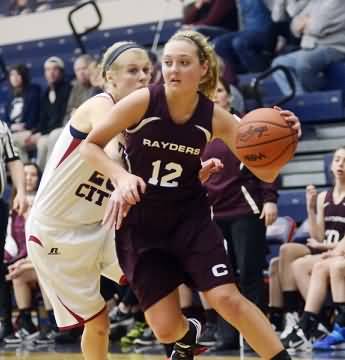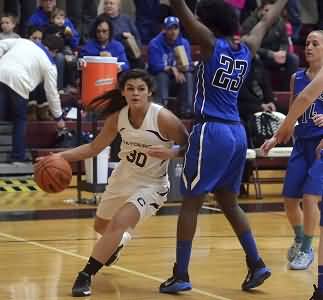Basketball Fundamentals - Offensive Tips for Youth Players
By Dr. James Gels, from the Coach’s Clipboard Basketball Playbook1. Practice, practice, practice shooting. Work on your shooting form, the "platform", "L", "hinge" and "gooseneck" so that you learn to shoot with your fingertips and get back-spin ("rotation") on your shot. You may not be strong enough yet, but most good shooters eventually learn this.
To perfect your shooting technique, practice shots within just a few feet of the basket, every day. Then practice lay-ups, free-throws, 2-pointers, even 3-pointers, and learn to shoot a jump-shot. Don't be afraid to take a good shot. Look for a chance to shoot. But don't force bad shots. See Shooting Fundamentals, Form and Technique.
2. Become a good dribbler and ball-handler. Dribbling, ball-handling, and footwork are the foundation skills for almost any offensive move with the ball. Practice dribbling drills and moves for 15 minutes every day (see Dribbling, Stationary Dribbling Drills, and Sideline Dribbling Drills).

4. Be a good passer. Bad passing and turnovers will destroy a team faster than anything. Make good, short, quick, crisp passes as they are harder to intercept. Avoid long cross-court passes until you are strong enough and unless your teammate is wide open. Use your peripheral vision and avoid throwing the ball to your opponent.
Make a pass that your teammate can easily catch. A good passer can pass to a teammate without looking. Avoid telegraphing your passes. Make good bounce passes. Learn when not to pass and avoid passing into a crowd.
5. Court awareness. Always know where the ball is - don't turn your back on the ball. Survey the court. Look for the open teammate with your peripheral vision. Look to the weak side of the floor for an easy back-door pass and lay-up. Learn to cut and find an open area on the floor, where your teammate can pass to you for an easy shot.
6. Except for the point guard, go hard for the offensive rebound. Many easy baskets are scored on second and third chances (see Rebounding Tips, Techniques and Fundamentals).
The point guard O1 should stay back out on top as a safety to prevent the opponent's fast break (if the opponent gets the rebound). If O1 drives to the basket, O2 (or O3) should stay back.
Otherwise, follow your shot after you shoot. If your shot is too short, it will come off the rim right back toward you. You may get a second chance to make that basket.
Three of the five players should go hard for the offensive rebound, one is half-rebounding and half-preventive mode, and one is always back to prevent the opponent's fast break.
7. Get the ball up the floor quickly, and fast-break whenever possible to beat the defense up the court. But play under control at all times. Don't try to go faster than you are able as you'll lose the ball or make a bad pass. It's difficult even for high school players to learn how to play with quickness and speed, while still staying under control. Remember: "You must be quick but never hurry."

9. Post players (O4 and O5) must develop basic post moves - the drop-step, jump hook, and up and under moves. Ask your coach to teach you these moves. After learning these basic moves, you can develop other variations of these moves. See How to Become a Good Post Player.
10. Move without the ball. Don't stand still. Set screens, fill open spots on the court, make cuts through the paint, or "back-door". Be ready to rebound. (See Moving Without the Ball, Cutting and Faking).